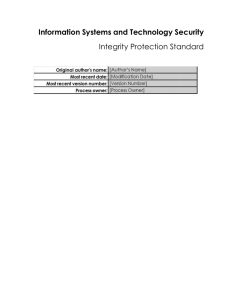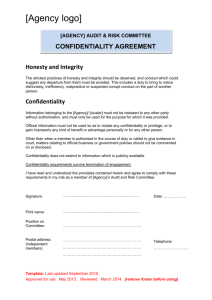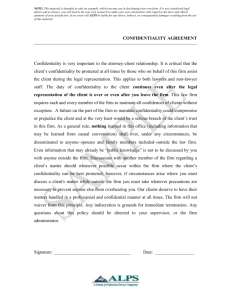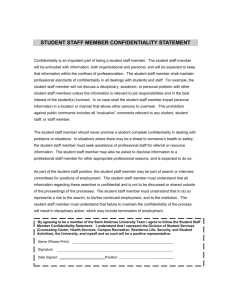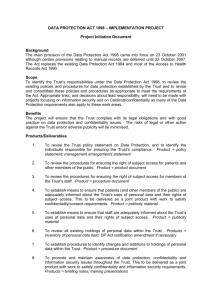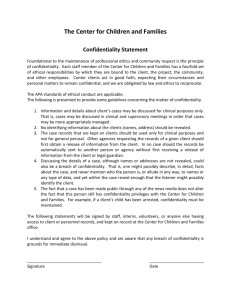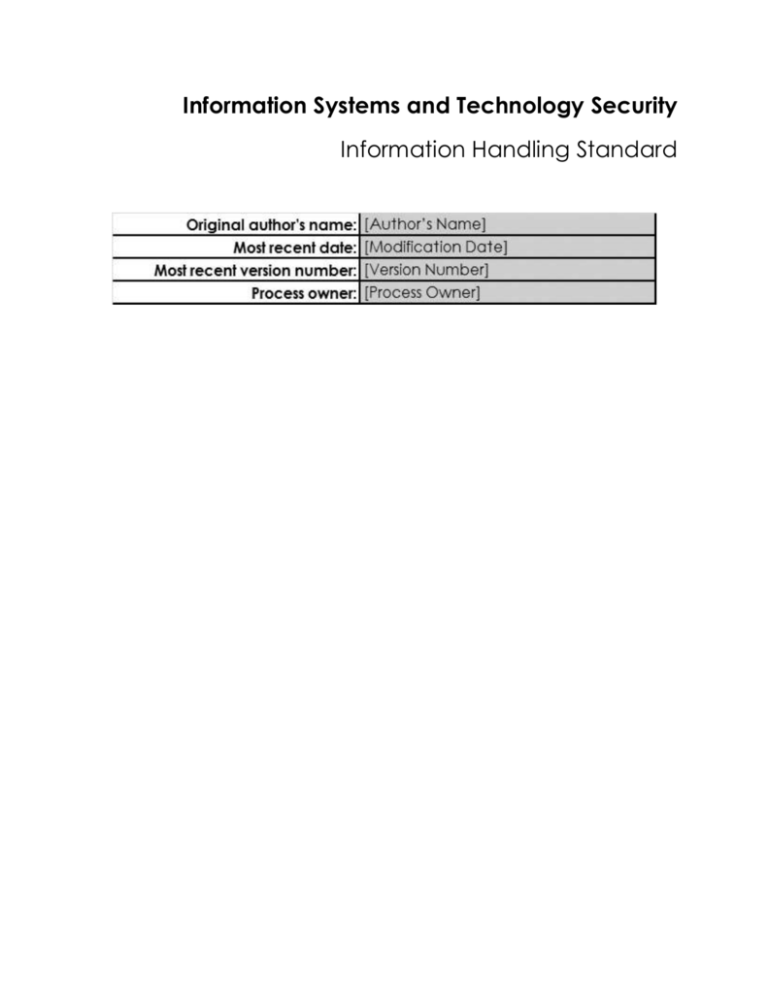
Information Systems and Technology Security
Information Handling Standard
Document History
Copyright © [Creation Date] [Company Name]
All rights reserved. This document is for internal use only. No part of the contents of this
document may be reproduced or transmitted in any form or by any means without
the expressed written permission of [Company Name].
Information Handling Standard
The [Company Name] (the "Company") Asset Protection Standard defines
objectives for establishing specific standards for protecting the confidentiality,
integrity, and availability of Company information assets.
This Information Handling Standard builds on the objectives established in the
Asset Protection Standard, and provides specific instructions and requirements
for handling information assets. These instructions address handling requirements
for printed, electronically stored, and electronically transmitted information.
1. Scope
All employees, contractors, part-time and temporary workers, and those
employed by others to perform work on Company premises or who have been
granted access to Company information or systems, are covered by this
standard and must comply with associated guidelines and procedures.
Confidentiality classifications are defined in the Information Classification
Standard.
Information assets are defined in the Asset Identification and Classification
Policy.
Exchangeable media refers to diskettes, tapes, removable hard drives,
compact disks, etc.
2. Requirements
a. Printed Information
i. All printed information shall be handled based on its confidentiality
classification. A description of handling requirements for each
confidentiality classification category is provided in the following
table:
b. Electronically Stored Information
i. All electronically stored information shall be handled based on its
confidentiality classification. A description of handling requirements
for each confidentiality classification category is provided in the
following table:
c. Electronically Transmitted Information
i. All electronically transmitted information shall be handled based on
its confidentiality classification. A description of handling
requirements for each confidentiality classification category is
provided in the following table:
3. Responsibilities
The [Security Executive's Title] approves the Information Handling Standard. The
[Security Executive's Supervisor Title] also is responsible for ensuring the
development, implementation, and maintenance of the Information Handling
Standard.
Company management, including senior management and department
managers, is accountable for ensuring that the Information Handling Standard is
properly communicated and understood within their respective organizational
units. Company management also is responsible for defining, approving and
implementing procedures in its organizational units and ensuring their
consistency with the Information Handling Standard.
Asset Owners (Owners) are the managers of organizational units that have
primary responsibility for information assets associated with their functional
authority. When Owners are not clearly implied by organizational design, the
[Security Executive's Supervisor Title] will make the designation. The Owner is
responsible for ensuring that the Information Handling Standard is properly
communicated and understood within their respective organizational units, as
well as defining, approving and implementing procedures in its organizational
units and ensuring their consistency with the Information Handling Standard.
Record Retention Owners (Owners) are the managers of organizational units that
have primary responsibility for information assets associated with their functional
authority. When Owners are not clearly implied by organizational design, the
[Security Executive's Supervisor Title] will make the designation. The Owner is
responsible for defining processes and procedures that are consistent with the
Legal Retention Management Standard; coordinating with the Information
Security Department to ensure that Company protection standards are properly
established and maintained; and ensuring that accurate and updated
information on network devices and servers; data storage devices issued by the
company; and record handling systems in the production environment is
retained. The Owner is responsible for identifying the various permeations that
employees store and save information (i.e., some employees may save
documents to a hard drive while others to a network file share).
Asset Custodians (Custodians) are the managers, administrators and those
designated by the Owner to manage process or store information assets.
Custodians are responsible for providing a secure processing environment that
protects the confidentiality, integrity, and availability of information and
coordinating with administrators to ensure proper handling of information during
processing and storage.
Record Custodians (Custodians) are the managers, administrators, and those
designated by the Owner to manage, process, or store information assets.
Custodians are responsible for providing a secure processing environment that
protects the confidentiality, integrity, and availability of information;
coordinating with the Information Security Department to ensure that Company
record protection standards are properly established and maintained in
accordance with established Company record hold standards.
Users are the individuals, groups, or organizations authorized by the Owner to
access to information assets. Users are responsible for familiarizing and
complying with the Information Handling Standard and associated guidelines,
and handling information in manner that is consistent with the Information
Handling Standard.
4. Enforcement and Exception Handling
Failure to comply with the Legal Retention Management Standard, Information
Handling Standard, and associated guidelines and procedures can result in
disciplinary actions up to and including termination of employment for
employees or termination of contracts for contractors, partners, consultants, and
other entities. Legal actions also may be taken for violations of applicable
regulations and laws.
The following Case Request Form Sample illustrates the necessary key elements
that should be preserved or considered if available during a litigation hold
request event.
Case Request Form
This form should be completed and sent to Information Security when an asset
must be forensically analyzed. If possible, do not handle the asset without the
assistance of an Information Security representative. The Information Security
department will assign the [Company Name] Case Number, Analyst Contact
and Legal Contact. All other information should be completed by the requestor.
Case Subject and Requestor Information
Please check the spaces applicable to this legal hold request below. If specific
information concerning the case is available, please supply this information in
the Keyword Search Parameters spaces provided. Unless a full image is required,
only selected data will be held.
The Case Request Form may be obtained by contacting Information Security.
Upon receipt of notice of significant defensive litigation and or material threat of
litigation, the Chair of the Record Hold/Discovery Subcommittee shall direct the
appropriate Company employee or employees to proceed with suspension of
routine destruction of all relevant documents, to include, but not be limited to,
email, communications, or other electronically stored data documents created
by Company employees.
The General Counsel and or his designee shall notify employees of the
Company identified as likely to have relevant information to the significant
defensive litigation and or material threat of litigation of the need for the
litigation or other legal hold and of their obligations to suspend routine record
and other electronic document or physical document destruction.
Requests for exceptions to the Information Handling Standard should be
submitted to the Company [Security Executive's Title]. Exceptions shall be
permitted only on receipt of written approval from the [Security Executive's Title].
The [Security Executive's Title] will periodically report current status to the
Company [Security Executive's Supervisor Title] or its designee.
5. Review and Revision
The Information Handling Standard will be reviewed and revised in accordance
with the Information Security Program Charter.
Recommended: ________________________
Signature
[Name]
[Security Executive's Supervisor Title]
Approved: ____________________________
Signature
[Name]
[Security Executive's Supervisor Title]


